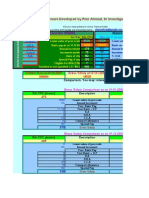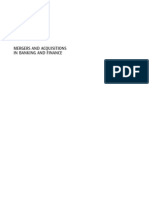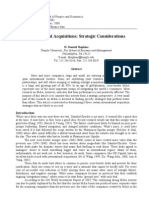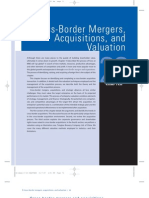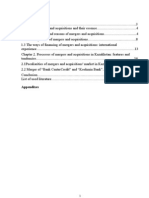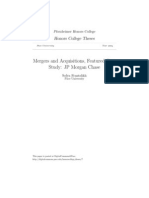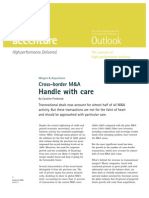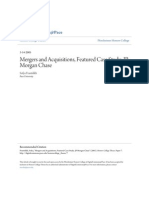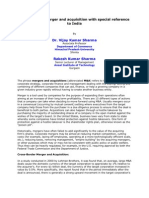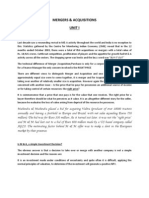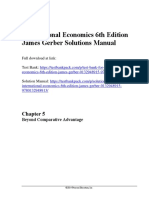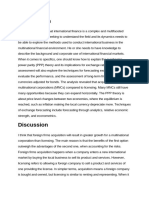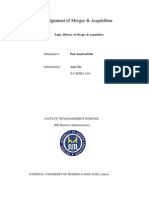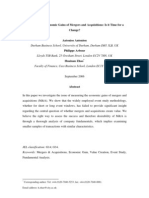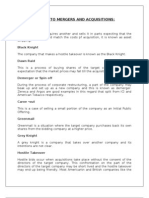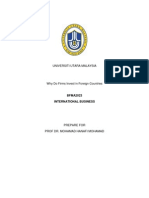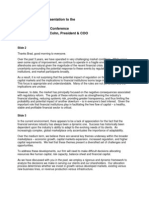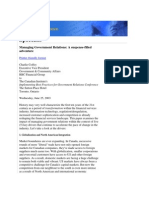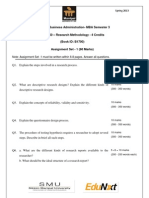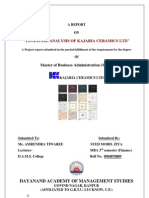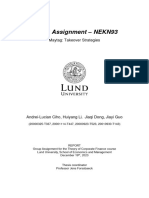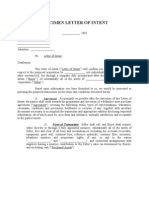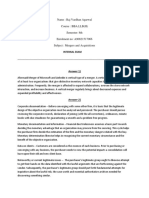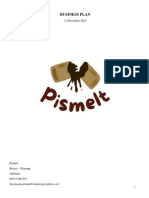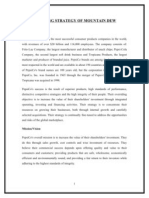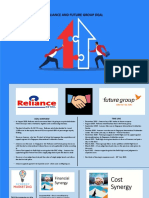1 Cross Border Merger Muzaffar Islam
1 Cross Border Merger Muzaffar Islam
Uploaded by
pratiksha1091Copyright:
Available Formats
1 Cross Border Merger Muzaffar Islam
1 Cross Border Merger Muzaffar Islam
Uploaded by
pratiksha1091Original Description:
Copyright
Available Formats
Share this document
Did you find this document useful?
Is this content inappropriate?
Copyright:
Available Formats
1 Cross Border Merger Muzaffar Islam
1 Cross Border Merger Muzaffar Islam
Uploaded by
pratiksha1091Copyright:
Available Formats
MUZAFFAR ISLAM Author is a student of LLB-III. He is Head Study Circle and Joint Editor of QLCian.
He represented Pakistan in SAARCLAW INTERNATIONAL MOOT COMPETITION HELD IN NEW DELHI, INDIA.
Cross-Border Merger & Acquisition
(Foreign Direct Investment)
Cross-Border Merger & Acquisitions implementation is an art, not a science. Each situation is unique and presents its own set of problems and potential solutions but it is in fact viable vehicles for international strategy.
The globalization of business over the past decade has spawned a search for competitive
advantage that is worldwide in scale. Companies have followed their customers who are going global themselves as they respond to the pressures of obtaining scale in a rapidly consolidating global economy. In combination with other trends, such as increased deregulation, privatization, and corporate restructuring, globalization has spurred an unprecedented surge in cross-border merger and acquisition activity. 1 Crossborder mergers and acquisitions are an imperative part of the accelerated economic globalization of our time. Cross-border transaction volume now accounts for almost onethird of global M&A activity and this number will only increase as business world-wide continues to expand. The complex legal issues to be handled in such transactions encompass the coordination of different concepts of corporate governance and capital market regulations in the laws involved, as mirrored by the intense debate on M&A law making within the European Union, and for example Germany. Lawyers engaged in the M&A practice will inevitably be confronted with cross-border transactions and will have to appropriately counsel their clients in the variable aspects of the law. Cross-Border Mergers and Acquisitions and the Law, a book based on an international conference held by the Law Centre for European and International Cooperation (R.I.Z.) in cooperation with the Centre of Commercial Law Studies, the Asian Institute of International Financial Law, and the SMU Institute of International Banking and Finance, provides a comprehensive exploration of the legal implications of a cross-border merger or acquisition. Applying a comparative approach, the compilation of articles by professors, practitioners and bankers provides thorough information on topics including Business Combination Agreements; Securities Regulation and Stock Exchange Listing Requirements; Tax Considerations; International M&As and International Accounting Standards; Financial Techniques and Legal Considerations in International Mergers and Hostile Take-Over; Antitrust Laws in the United States and Europe and their Extraterritorial Reach; Bank Mergers and Bank Supervisory Law.2 BOX 1.1 to (M&A) Securities Data Corporation, there than 2000 Mergers andAccording acquisitions and corporate restructuring are a big were part ofmore the corporate finance announced cross-border acquisitions in 1996 worth over $256 billion. this world. Every day, Wall Street investment bankers arrange M&A transactions, which While bring separate companies together form larger ones. When they're not creating big companies from smaller ones, represents 54%tomore acquisitions than in 1991, the increase in dollar value been even more remarkable, tripling during this time period. Clearly cross border M&As have become a fundamental characteristic of the global business landscape. .3
corporate finance deals do the reverse and break up companies through
spin-offs, carve-outs or
tracking stocks.
BOX 1.2 One plus one makes three: this equation is the special
alchemy of a merger or an acquisition. The key principle behind buying a company is
to create shareholder value over and above that of the sum of the two companies. Two companies together are more valuable than two separate companies - at least, that's the
Mergers are generally differentiated from acquisitions partly by the way in which they are financed and partly by the relative size of the companies
reasoning behind M&A.
In a study conducted in 2000 by Lehman Brothers, it was found that, on average, large M&A deals cause the domestic currency of the target corporation to appreciate by 1% relative to the acquirer's. For every one billion dollar deal, the currency of the target corporation increased in value by 0.5%. More specifically, the report found that in the period immediately after the deal is announced, there is generally a strong upward movement in the target corporation's domestic currency (relative to the acquirer's currency). Fifty days after the announcement, the target currency is then, on average, 1% stronger. The rise of globalization has exponentially increased the market for cross border M&A. In 1996 alone there were over 2000 cross border transactions worth a total of approximately $256 billion. This rapid increase has taken many M&A firms by surprise because the majority of them never had to consider acquiring the capabilities or skills required to effectively handle this kind of transaction. In the past, the market's lack of significance and a more strictly national mindset prevented the vast majority of small and mid-sized companies from considering cross border intermediation as an option which left M&A firms inexperienced in this field. This same reason also prevented the development of any extensive academic works on the subject.
Managing the Cross-Border Merger & Acquisition
Process of Combination Phase 1: Pre-combination Phase 2: Combination planning and signing of the agreement Phase 3: Post-combination and implementation of the deal
Strategic reasons for the Acquisition
In recent years strategic mergers have gotten a bad name, to the extent that some pundits have defined strategic mergers as those where the acquiring company overpays. While the price paid for a company is a critical determinant of the success of the resulting Acquisition, there is no inherent reason, why mergers that are strategically well conceived, should go away. In fact, the evidence is quite opposite. The recent merger of British Petroleums (BP) and Mobils downstream operations across Europe are a case in point. The strategic 3 logic for this deal says that size and market power are required to compete against the other major oil companies and even supermarket chains with gas pumps, in Europe, and significant cost savings can be realized by eliminating duplicate facilities and employees, and by rationalizing purchasing and cutting overhead. Although this merger is not without significant integration challenges, it appears to have a solid strategic logic, and indeed is considered a blueprint for similar deals among rivals such as Shell, Texaco, and Amoco. It is also an unusual merger since BP and Mobil are only consolidating their refining and marketing operations in Europe, and remain rivals elsewhere. Nevertheless, estimates of cost savings are in the range of $500 million a year, a figure which, if established and maintained, will clearly make this merger a success. The keys to establishing an effective strategic logic lie in answering questions such as:
BOX 1.4 How will this merger create value, and when will this value be realized? Why are we a better parent for this company than someone else? Can this merger pass the better-off test will we be able to create more value (by being more competitive, having a stronger cost structure, gaining additional competencies that we can leverage in new ways, etc.) after the deal? 5
These are difficult questions that require careful, objective & pre-acquisition analysis. The tendency for companies in the heat of battle to overstate the real strategic benefits of a deal is a definite problem that must be guarded against pressures that arise from the desire to close a deal quickly before rival bidders appear, cultural and sometimes language barriers that create uncertainty, and the often emotionally charged atmosphere surrounding negotiations, work against this requirement of objectivity. The best solution in this case is to enter the M&A mode with a carefully developed framework that addresses the key questions, and to stick to that framework in evaluating a potential acquisition candidate even when the seemingly inevitable strains arise. Our own research and experience indicates that the highest potential cross border M&As tend to be between firms that share similar or complementary operations in such key areas as production and marketing. When two companies share similar core businesses there are often opportunities for economies of scale at various stages of the value chain (e.g., R&D, manufacturing, sales and marketing, distribution, etc.). For example, although the merger between British Telecom and MCI remains controversial and losses associated with MCIs push to enter the local telephone service market in the U.S. are not reassuring there are opportunities for value creation through common software development, shared
capital investment, and joint purchasing agreements. The strategic logic of combining complementary assets can also be compelling. These assets, which extend to complementary competencies in technology and know-how, offer great opportunities for companies to create value in the right circumstances. For example, MCI will be a much more formidable competitor in the U.S. telephone market with the backing of BT and its prodigious cash flow. Other potential complementary benefits of this deal include the positive impact of MCIs aggressive market-oriented corporate culture on the more conservative British Telecom, and the potential of the combination itself to be a wellpositioned global competitor as evolving markets in Europe and the U.S. continue to deregulate and change. Thus, what we call economies of fitness arising from complementary operations or competencies can be an important source of value creation in mergers and acquisitions.6
Complications in Implementation of Cross Border M & A
BOX 1.3 Due to the complicated nature of cross border M&A, the vast majority of cross border actions have unsuccessful results. Cross border intermediation has many more levels of complexity to it then regular intermediation seeing as corporate governance, the power of the average employee, company regulations, political factors customer expectations and countrys culture are all crucial factors that could spoil the transaction. Because of such complications, many business brokers are finding the International Corporate Finance Group and organizations like it to be a necessity in M & A today.7
Consider all that must go right in any (same-country) acquisition: The two companies must reach agreement on which products and services will be offered, which facility or group will have primary responsibility for making this happen, who will be in charge of each of these facilities or groups, where will the expected cost savings come from, what will the division of labor look like in the executive suite, what timetable to follow that will best generate the potential synergies of the deal, and myriad other issues that are complex, detailed, and immediate. On top of all this the merging companies must continue to compete and serve their customers in a competitive marketplace. Now, take all these challenges, and add a completely new set of problems that arise from the fundamental differences that exist across countries. Consider, for example, for all the similarities that a global imperative places on companies, the very real differences in how business is conducted in, say, Europe, Japan, and the United States. These differences involve corporate governance, the power of rank and file employees, worker job security, regulatory environments, customer expectations, and country culture all representing additional layers of complexity that executives engaged in cross-border M&As must manage. Is it any wonder that cross border mergers are potential minefields that require the utmost care? Fortunately, there are some basic principles that will make cross-border mergers work more smoothly. They can be divided into the imperatives of strategic logic and acquisition integration.8
Summary of Barriers in Implementation of Cross-Border M&A9
Legal Barriers
Legal uncertainty Opaque decision making processes 3. Legal structures 4. Limits or controls on foreign participations 5. Defense mechanisms 6. Impediments to effective control 7. Difficulties to assess the financial situation 8. Restriction on offers 1. 2.
Tax Barriers
Implications of Supervisory Rules
Economic Barriers
Attitudinal Barriers
35. Political Interference 36. Employees reluctance 37. Shareholder acceptance of quotation changes 38.Shareholder and analyst apprehension of failure risk
a) Execution Risks
14. Uncertainty on Tax arrangements 15. Uncertainty on VAT regime
23. Concerns regarding financial stability 24. Misuse of supervisory Powers 25.Supervisory Approval Process
b) On-Off Costs
16. Exit tax on capital gains 17. Transferring Pricing 18. Inter-Group VAT 19. No Homogenous Loss Compensation 20. Specific Domestic Tax breaks 21.Discriminatory Tax Treatments 22. Taxation on Dividends
C) OnGoing Cost
Employment legislation 10. Accounting systems 11. Divergent consumer protection rules 12. Data protection 13. Differences in Private Law
9.
26. Divergences in supervisory Practices 27. Multiple reporting requirements
28. Fragmentation of the European Commercial Market 29. Different Product Mixes 30.NonOverlapping Fixed Costs 31. Lack of middlesize institutions 32. Absence of critical size 33.Market Power 34. Differences in Economic Cycle
39. Political Concessions 40. Consumer Mistrust in foreign entities
Cultural Integration in the Process of Cross-Border Merger and Acquisition
Cross-border mergers and acquisitions (M&A) play an important part in foreign direct investment (FDI). In the process of cross-border M&A, the enterprises involved will encounter cultural differences and conflicts. How to integrate these cultural differences and eliminate the conflicts becomes an important issue for the enterprises. Cultural integration eliminates conflicts arising from cultural differences by organizing and amalgamating the values, psychological states and behavior modes of different communities. The cross-border M&A cultural integration inherits and rectifies the psychological contract of the target company for minimizing the amount of cultural conflicts and forming the diversity and unity due to the cultural differences in multinational enterprises (Gu & Xue, 2004). Cross-border M&A cultural integration seek to reduce cultural differences as much as possible in the acquired company. Therefore, whether the cultural integration is successful or not is critical to the success or failure of a cross-border M&A. In general, the following problems should be solved in cultural integration of cross-border M&A. First, it should coordinate the cultural differences of peoples and states to promote understanding and communicating between the different
communities in one enterprise and to avoid the negative influence arising from the different thinking models, behaviors, and values. Second, it should coordinate the different company cultures to eliminate the barriers in leadership styles, communication models, personnel system, performance appraisals, and social security benefits. Third, it should establish the companys core values by integrating diverse cultures to improve the companys creativity and competitiveness. Fourth, the effective integration of the companies cultures could provide conditions beneficial for the integration of operations. Therefore, cultural integration of cross-border M&A plays an important role in helping the company maximize its capital, technique, sales, and other advantages.
Method for Cultural Integration of Cross-Border M&A
Cultural integration of cross-border M&A is a process to coordinate diverse cultures and make them mutually exist and develop within an enterprise. However, cultural integration is not as simple as merging all the different cultures into one, but a process to form a new multinational corporate model by selecting, absorbing, and integrating cultures. Cross cultural management is an effective method of realizing the cultural integration of crossborder M&A successfully. Cross-cultural management refers to a system that an enterprise, in the course of M&A, selects adaptive pattern of cross-culture management, overcomes conflicts and unfavorable influences, converts the negative factors into positive factors, and gains power of the cultural synergy. Cross-cultural management has its own principles and patterns, which shall be followed in the process of fulfilling crosscultural management. Basic principles of cross-cultural management lie in respecting and understanding the cultures of others, placing importance on communication, and making adaptive changes. People are the core of cross-cultural management. Culture is reflected in the thinking and behavior of people. Management is all about getting the best performance out of people. The buyer should respect the culture of the target company and try to understand the culture. The company should not use fixed values to judge the other companys culture, but should synthesize the companys strategic significance with its culture. Communicating with each other effectively and understanding each others culture is the most effective way to eliminate cultural conflicts. Establishing a new culture after M&A is the amalgamation of different cultures and need not have the cultural imprint of a certain country or nationality. It will be a combination of different cultures. These four principles are interdependent and in the whole make up the basic principles of Cross-cultural management. There are four models of cross culture management to resolve the cultural differences between the buyer and target companies. The first model is localization strategy, which refers to when each subsidiary of the company located in other regions or nations is regarded as an independent entity so that the strategy and decision of the subsidiary can be made according to the local conditions. The parent companys operating model is not imposed on the subsidiary. Rather, the management policy is made according to the local conditions. When the company is recruiting managers or other staff, there is little consideration given to their nationality or where they come from. The buyer respects the local culture and benefits from the localization strategy. The second model is transplanting the culture of the parent company. In this model, the buyer appoints its people to manage the target company in order to guarantee communication between the buyer and the target, and the buyer
supervises and controls the target. As a result, the buyer can transplant its culture into the target company and gradually get the local staff to accept its culture. The third model is the cultural innovation by integration. In this model, the cultures of buyer and target companies coexist; a new culture and management pattern are formed through the integration of the two cultures. Cultural innovation can maximize the cross-cultural advantage. The fourth pattern uses evasion tactics. In this model, when there is a tremendous cultural gap between the buyer and the target, it is necessary for the manager appointed by the buyer to avoid the key cultural differences. Under this circumstance, the third party shall be asked to bridge the gap between cultures. This model does not address the problem and has considerable limitations. In general, it only can be used as a transitional method. Buyers can select one or a combination of two or more of these four patterns, taking into consideration the cultural character of themselves and their targets, to culturally integrate.10
The role of Human Resource Management and Cross-Border M&A
The role of HRM in cross-border M&As before conducting our analysis, we briefly review the nature of the merger process. The literature has dissected the M&A process into three main stages: pre-announcement; pre-merger; and integration. The preannouncement stage involves due diligence. Issues discussed among potential merging firms in this stage are M&A strategy and the financial structure of the deal. The premerger stage occurs between the announcement of the merger and its closing date and includes planning for the integration, such as communicating expected roles in the newly formed entity. The integration stage implies the physical integration of the various elements of the M&A following the closing date, including personnel. In theory, HRM can have an influence on the success of M&As in each stage of the process. For example, during the pre-merger stages, HRM tends to focus on ensuring legal compliance, such as with regard to equal opportunity and collective bargaining agreements (Mirvis and Marks, 1992). HRM can also begin the planning process following deal announcement, for instance by managing retention agreements and assessing compensation differences between the potentially merging entities. Nevertheless, evidence and practice indicate that the main role in which HR can influence M&As is in the integration stage, when M&A practices and policies are implemented. 11
Foreign Acquisitions And Mergers
With the rapid growth in Pakistan's economy, foreign investors are taking a keen interest in the corporate sector of Pakistan. In the recent years, majority stakes in many corporations have been acquired by multinational groups. 12 PICIC by Singapore based Tamasek holdings for $339 million Union Bank by Standard Chartered bank for $487 million Cross-border M&A purchases: Asia Pacific, 1990-1996 (In US Million $) 13 Prime commercial bank by ABN Amro for $228 million PakTel ltd by China Mobile Ltd for $460 million Additional 57.6 percent shares of Lakson Tobacco company acquired by Total 1990-1996 Philip Morris international for $382 million 1990 1991 1992 1993 1994 1995
1996
Deals Japan 3,178 Hong Kong 650 Australia 584 Malaysia 356 Korea 337 Singapore 518 China 187 Thailand 128 Taiwan 163 New Zealand Indonesia 76 India 52 Philippines 21 Brunei 8
Value
Deals
Value
Deals
Value
Deals
Value
Deals
Value
Deals
Value1
Deals
Value
Deals
Value
93,813.371 699
25,132.680 550
8,958.815 320
12,525.037 306
7,193.867 350
10,466.546
498
16,963.018
455
12,573.408
30,907.742
39
1,132.169
55
852.118
80
9,558.622 141
8,388.019 145
3,413.563
111
3,920.997
79
3,642.254
23,683.622
77
2,084.391
71
1,039.310
75
2,733.147
71
2,965.759 106
3,855.686
102
5,568.624
82
5,436.705
15,439.766
160.151
13
235.455
15
143.348
41
1,219.861
98
7,020.704
86
1,252.910
98
5,407.337
15,200.842
30
475.412
28
374.522
26
778.774
24
846.762
53
3,555.335
95
6,012.351
81
3,157.686
11,912.602
23
243.150
23
416.790
41
553.801
85
2,117.315 124
1,810.581
115
2,764.603
107
4,006.362
11,810.122
1,336.400
102.780
27
1,688.302
70
5,450.280
29
1,635.793
34
200.392
19
1,416.175
7,290.200
14.710
10
1,638.400
19
533.361
33
180.618
34
3,576.788
23
1,346.323
6,976.457
23
1,259.429
11
136.560
18
1,001.315
23
882.184
20
760.024
45
821.228
23
2,115.717
117
4,145.969
31
974.417
11
141.150
17
603.117
17
807.938
15
78.177
11
481.409
15
1,059.761
2,307.838
187.300
57.970
106.450
13
247.349
14
519.328
23
614.827
11
613.993
1,512.147
270.000
421.916
12
619.460
21
200.777
515.190
18.450
50.500
433.240
11.000
2.000
470.663
4.400
202.000
1.000
81.700
181.563
Pakistan 2
Vietnam 9 Bangladesh 1 Macau 2 Cambodia 2 7.650 1 0 1 7.650 10.000 1 10.000 1 0 11.867 1 11.867 27.060 1 0 1 0 2 19.500 3 4.500 1 1.500 1 1.560
107.206
106.667
0.539
Nepal 1 Myanmar 2 Mongolia 1 Total 6,390 226,153.71 939 32,985.50 786 12,623.03 652 31,928.90 812 30,854.70 1,010 34,372.21 1,185 42,483.99 1,006 40,964.78 0.76 1 0.76 1.020 1 0 1 1.020 3.400 1 3.400
These cross-border transactions enable clients to achieve global reach through international acquisitions, and to maximize value through the sale of their business to international strategic acquirers.
Major M&A in 1990s 14
Rank Year Purchaser Purchased Transaction value (in mil. USD) 183,000 90,000 77,200 73,000 63,000 60,000 53,630 53,000 48,000 42,000
1 2 3 4 5 6 7 8 9 10
1999 1999 1998 1999 1999 1999 1999 1998 1999 1997
Vodafone AirTouch Pfizer Exxon Citicorp SBC Communication Vodafone Group Bell Atlantic BP Qwest Communication WorldCom
Mannesmann Warner-Lambert Mobil Travelers Group Ameritech Corp. AirTouch GTE Amoco US West MCI Communicarion
Major M&A from 2000 to Present 15
Rank Year Purchaser Purchased Transaction value (in mil. USD) 164,747 75,961 74,559 72,671 72,041
1
2
2000
2004
3
4
2004
2006
2001
America Online Inc. Glaxo Wellcome Royal Dutch Petroleum Co. AT&T Inc. Comcast Corporation
Time Warner SmithKline Beecham Plc. Shell Transport & Trading Co Bell South Corp. AT&T Broadband
6 7 8 9 10
2004 2000 2002 2004 2000
Sanofi-Synthelabo Spin-off: Nortel Networks Corporation Pfizer Inc. Pharmacia Corporation JP Morgan Chase Bank One Corp & Co Fusion: America Time Warner Online Inc.
& Internet Service Aventis SA
60,243 59,974 59,515 58,761 164,747
Notes and References
1. This is a summary of an article that appeared in Financial Times Mastering Global Business: The Complete MBA Companion in Global Business, London: Financial Times Pitman Publishing.Finkelstein, S. 1999. "Safe ways to cross the merger minefield." p. 119123.Sydney Finkelstein is the Steven Roth Professor of Management at the Tuck School of Business at Dartmouth 2. Cross-Border Mergers and Acquisitions and the Law: A General Introduction (Studies in Transnational Economic Law) www.target.com. 3. Cross-Border Mergers and Acquisitions by Sydney Finkelstein
4. www.wikipedia.org
5. FDI into Pakistan jumps 180.6% in 1st 9 months of FY06 6. Pakistan News Service - PakTribune 7. Daily Times - Leading News Resource of Pakistan 8. Private Equity in Pakistan, Israel, and Egypt, by Sethi, Arjun Nov 2007, accessed December 29, 2007. 9. Macroeconomic Stability of Pakistan: The Role of the IMF and World Bank (19972003) 10. International Management Review Vol. 3 No. 2 2007 The Cultural Integration in the Process of Cross-border Mergers and Acquisitions Zhanwen Zhu, Haifeng Huang Chinas Research Center for Economic Transition, Beijing University of Technology, China 11. The role of human resource management in cross-border mergers and acquisitions Ruth V. Aguilera and John C. Dencker Int. J. of Human Resource Management 15:8 December 2004 13551370 12. Lien, Kathy (2005-10-12). Mergers And Acquisitions - Another Tool For Traders. Investopedia. Retrieved on 2007-06-17. 13. Courtesy KPMG 14. &15. Facts collected from Wikipedia
Further Notes
Ahmad, Viqar and Rashid Amjad. 1986. The Management of Pakistans Economy, 1947-82. Karachi: Oxford University Press. Ali, Imran. 1997. Telecommunications Development in Pakistan, in E.M. Noam (ed.), Telecommunications in Western Asia and the Middle East. New York: Oxford University Press. Ali, Imran. 2001a. The Historical Lineages of Poverty and Exclusion in Pakistan. Paper presented at Conference on Realm, Society and Nation in South Asia. National University of Singapore. Ali, Imran. 2001b. Business and Power in Pakistan, in A.M. Weiss and S.Z. Gilani (eds), Power and Civil Society in Pakistan. Karachi: Oxford University Press. Ali, Imran. 2002. Past and Present: The Making of the State in Pakistan, in Imran Ali, S. Mumtaz and J.L. Racine (eds), Pakistan: The Contours of State and Society. Karachi: Oxford University Press. Ali, Imran, A. Hussain. 2002. Pakistan National Human Development Report. Islamabad: UNDP. Ali, Imran, S. Mumtaz and J.L. Racine (eds). 2002. Pakistan: The Contours of State and Society. Karachi: Oxford University Press. Amjad, Rashid. 1982. Private Industrial Investment in Pakistan, 1960-70. London: Cambridge University Press. Andrus, J.R. and A.F. Mohammed. 1958. The Economy of Pakistan. Stanford: Stanford University Press. Barrier, N.G. 1966. The Punjab Alienation of Land Bill of 1900. Durham, NC: Duke University South Asia Series. Jahan, Rounaq. 1972. Pakistan: Failure in National Integration. New York: Columbia University Press. Kessinger, T.G. 1974. Vilyatpur, 1848-1968. Berkeley and Los Angeles: University of California Press. Kochanek, S.A. 1983. Interest Groups and Development: Business and Politics in Pakistan. New Delhi: Oxford University Press. LaPorte, Jr, Robert and M.B. Ahmad. 1989. Public Enterprises in Pakistan. Boulder, Colorado: Westview Press. Latif, S.M. 1892. Lahore. Lahore: New Imperial Press, reprinted 1981, Lahore: Sandhu Printers.
Low, D.A. (ed.). 1991. The Political Inheritance of Pakistan. London: Macmillan. Noman, Omar. 1988. The Political Economy of Pakistan. London: KPI. Papanek, G.F. 1967. Pakistans Development: Social Goals and Private Incentives. Cambridge, Massachusetts: Harvard University Press. Raychaudhuri, Tapan and Irfan Habib (eds). 1982. The Cambridge Economic History of India, 2 vols. Cambridge: Cambridge University Press White, L.J. 1974. Industrial Concentration and Economic Power. Princeton, N.J.: Princeton University Press. Ziring, Lawrence. 1980. Pakistan: The Enigma of Political Development. Boulder, Colorado: Folkestone. Ali, Imran. August 2002. The Historical Lineages of Poverty and Exclusion in Pakistan, South Asia, XXV(2). Ali, Imran and S. Mumtaz. 2002. Understanding PakistanThe Impact of Global, Regional, National and Local Interactions, in Imran Ali, S. Mumtaz and J.L. Racine (eds), Pakistan: the Contours of State and Society. Karachi: Oxford University Press. Hasan, Parvez. 1998. Pakistans Economy at the Crossroads: Past Policies and Present Imperatives. Karachi: Oxford University Press. Hussain, Ishrat. 1999. Pakistan: The Economy of an Elitist State. Karachi: Oxford University Press.
Straub, Thomas: Reasons for frequent failure in Mergers and Acquisitions - A comprehensive analysis, Deutscher Universittsverlag, Wiesbaden 2007. ISBN 9783835008441
Platt, Gordon. Cross-Border Mergers Show Rising Trend As Global Economy Expands. findarticles.com. Retrieved on 2007-08, www.wikipedia.org
Abbrevations FDI M&A
Foreign Direct Investment Mergers and acquisitions State Bank Of Pakistan British Petroleum Microwave Communications, Inc.
SBP
BP MCI
HRM
Human Resource Management
You might also like
- Berkshire Hathaway CaseDocument4 pagesBerkshire Hathaway CaseRoderick Jackson Jr100% (3)
- 6th Central Pay Commission Salary CalculatorDocument15 pages6th Central Pay Commission Salary Calculatorrakhonde100% (436)
- 6th Central Pay Commission Salary CalculatorDocument15 pages6th Central Pay Commission Salary Calculatorrakhonde100% (436)
- 6th Central Pay Commission Salary CalculatorDocument15 pages6th Central Pay Commission Salary Calculatorrakhonde100% (436)
- 6th Central Pay Commission Salary CalculatorDocument15 pages6th Central Pay Commission Salary Calculatorrakhonde100% (436)
- 6th Central Pay Commission Salary CalculatorDocument15 pages6th Central Pay Commission Salary Calculatorrakhonde100% (436)
- 6th Central Pay Commission Salary CalculatorDocument15 pages6th Central Pay Commission Salary Calculatorrakhonde100% (436)
- 6th Central Pay Commission Salary CalculatorDocument15 pages6th Central Pay Commission Salary Calculatorrakhonde100% (436)
- Mergers and Acquisitions in Banking and FinanceDocument317 pagesMergers and Acquisitions in Banking and FinanceSunil ShawNo ratings yet
- FIN561 Week 1 HomeworkDocument2 pagesFIN561 Week 1 HomeworknguyenNo ratings yet
- Ch5Probset Bonds+Interest 13ed. - MasterDocument8 pagesCh5Probset Bonds+Interest 13ed. - Masterpratiksha1091No ratings yet
- RocheDocument7 pagesRochePrattouNo ratings yet
- Mergers and Acquisitions in Banking and FinanceDocument317 pagesMergers and Acquisitions in Banking and Financesachinvb2008No ratings yet
- Irjfe 15 DonaldDocument10 pagesIrjfe 15 DonaldAmit JohariNo ratings yet
- Cross Border AcquisitionDocument28 pagesCross Border AcquisitionIvory Joy SaleNo ratings yet
- Basics of Cross Border M&ADocument4 pagesBasics of Cross Border M&AJitaksh GNo ratings yet
- Cross-Border Mergers and AcquisitionDocument34 pagesCross-Border Mergers and AcquisitionAzan RasheedNo ratings yet
- Michael Mauboussin - Surge in The Urge To Merge, M&a Trends & Analysis 1-12-10Document15 pagesMichael Mauboussin - Surge in The Urge To Merge, M&a Trends & Analysis 1-12-10Phaedrus34No ratings yet
- Cross-Border Mergers and AcquisitionDocument34 pagesCross-Border Mergers and Acquisitionvarinder kumar KumarNo ratings yet
- Cross Border Mergers and AcquisitionsDocument33 pagesCross Border Mergers and AcquisitionsMaria ReisNo ratings yet
- M&ADocument30 pagesM&AMira AbdrakhmanovaNo ratings yet
- JP Morgan Chase-Bank One Merger Case StudyDocument74 pagesJP Morgan Chase-Bank One Merger Case Studydeep_enjoy91% (11)
- Cross Border M&ADocument36 pagesCross Border M&ATam NguyenNo ratings yet
- OutlookPDF MA 03Document10 pagesOutlookPDF MA 03Er Asmitaa KumarNo ratings yet
- Multinational Business Finance by Shapiro Chapter 1 SolutionsDocument10 pagesMultinational Business Finance by Shapiro Chapter 1 SolutionsEdward YangNo ratings yet
- MERGER AND ACCQUISITION Author Uddeshya UniyalDocument9 pagesMERGER AND ACCQUISITION Author Uddeshya UniyalShreya ModiNo ratings yet
- M&A JP MorganDocument74 pagesM&A JP MorganAntima Mind67% (3)
- Managing Across BoundariesDocument16 pagesManaging Across BoundariesPam UrsolinoNo ratings yet
- International Business EnvirnonmentDocument38 pagesInternational Business EnvirnonmentSimona StancioiuNo ratings yet
- Chap 8Document5 pagesChap 8Sinthya Chakma RaisaNo ratings yet
- Cross Boreder DiffinationDocument5 pagesCross Boreder DiffinationvishalllmNo ratings yet
- Multinational Financial Management 9th Edition Shapiro Solutions ManualDocument9 pagesMultinational Financial Management 9th Edition Shapiro Solutions ManualAlyssaCooksNo ratings yet
- Mergers & Acquisitions Unit I: Is M & A, A Simple Investment Decision?Document19 pagesMergers & Acquisitions Unit I: Is M & A, A Simple Investment Decision?reedbkNo ratings yet
- Mergers Acquisitions Sam ChapDocument24 pagesMergers Acquisitions Sam ChapMaria Mirabela StefanNo ratings yet
- FINAL ContemporaryDocument36 pagesFINAL Contemporaryelie lucidoNo ratings yet
- EcoN2305 Merger and AcuisationDocument9 pagesEcoN2305 Merger and Acuisationnaorin akterNo ratings yet
- Mergers and Acquisitions in The Context of GlobalizationDocument12 pagesMergers and Acquisitions in The Context of GlobalizationThe IjbmtNo ratings yet
- Niharika IDPDocument8 pagesNiharika IDPsamNo ratings yet
- International Economics 6th Edition James Gerber Solutions Manual 1Document7 pagesInternational Economics 6th Edition James Gerber Solutions Manual 1judith100% (61)
- Thesis Statement International TradeDocument9 pagesThesis Statement International Tradebeckiroymanchester100% (2)
- ICAI Research PaperDocument7 pagesICAI Research PaperManan ShahNo ratings yet
- FDIIIIDocument5 pagesFDIIIILouie ManaoNo ratings yet
- 12Document3 pages12czharmandeepkaurNo ratings yet
- Daryl Kayle SantosDocument5 pagesDaryl Kayle Santosdarylkaylesantos21No ratings yet
- Critical Assessment of Performance of Mergers and AcquisitionsDocument12 pagesCritical Assessment of Performance of Mergers and AcquisitionsThe IjbmtNo ratings yet
- How To Enter The International Market: Term Paper in International MarketingDocument15 pagesHow To Enter The International Market: Term Paper in International MarketingAcua RioNo ratings yet
- IBE AssignmentDocument7 pagesIBE AssignmentAishwarya KhopkarNo ratings yet
- Accenture - Why M&A PDFDocument16 pagesAccenture - Why M&A PDFAbhishek DaiyaNo ratings yet
- Model Answer: Course: MBA Semester: I Subject: International Business Environment and ManagementDocument7 pagesModel Answer: Course: MBA Semester: I Subject: International Business Environment and ManagementNabeelNo ratings yet
- History of M & ADocument7 pagesHistory of M & AAnas ZiaNo ratings yet
- SSRN ID932539 Code111831Document26 pagesSSRN ID932539 Code111831Marieta VanceaNo ratings yet
- Assignment No. 1 of Investment Banking: Topic: Mergers & AcquisitionDocument18 pagesAssignment No. 1 of Investment Banking: Topic: Mergers & AcquisitionChandan VirmaniNo ratings yet
- MBA402 International Business Management DDocument29 pagesMBA402 International Business Management Dminhazalam786No ratings yet
- Terms Related To Mergers and AcquisitionsDocument10 pagesTerms Related To Mergers and AcquisitionsAbhijeet SahaNo ratings yet
- Why Do Firms Invest in Foreign CountriesDocument9 pagesWhy Do Firms Invest in Foreign CountriesDelta YakinNo ratings yet
- Wang and Boateng 2007. Cross Border M&a by ChineseFirms...Document12 pagesWang and Boateng 2007. Cross Border M&a by ChineseFirms...Jingshu ZhangNo ratings yet
- Goldman Sachs Presentation To The Sanford Bernstein Strategic Decisions Conference Comments by Gary Cohn, President & COODocument7 pagesGoldman Sachs Presentation To The Sanford Bernstein Strategic Decisions Conference Comments by Gary Cohn, President & COOapi-102917753No ratings yet
- Merger and Acquisition of Financial Institutions: Page - 1Document8 pagesMerger and Acquisition of Financial Institutions: Page - 1Mishthi SethNo ratings yet
- Merger and AcquisitionDocument11 pagesMerger and AcquisitionPriyanka AgarwalNo ratings yet
- Summer Training Project Report OnDocument100 pagesSummer Training Project Report Onayaanshariq99No ratings yet
- Creating Value Beyond The Deal: Financial Services: Maximise Success by Keeping An Intense Focus On Three Key ElementsDocument24 pagesCreating Value Beyond The Deal: Financial Services: Maximise Success by Keeping An Intense Focus On Three Key ElementsNick HuNo ratings yet
- Managing Govt RelationsDocument9 pagesManaging Govt RelationsJanardhan PenchalaNo ratings yet
- The What, The Why, The How: Mergers and AcquisitionsFrom EverandThe What, The Why, The How: Mergers and AcquisitionsRating: 2 out of 5 stars2/5 (1)
- What is Public Procurement?: Procurement ClassRoom Lesson, #1From EverandWhat is Public Procurement?: Procurement ClassRoom Lesson, #1No ratings yet
- MB0050 Assignment Spring 2013Document1 pageMB0050 Assignment Spring 2013amriksingh81No ratings yet
- PumaprojectDocument30 pagesPumaprojectSuhail N R PuraNo ratings yet
- Project Report On Financial Statement Analysis of Kajaria Ceramics Ltd.Document121 pagesProject Report On Financial Statement Analysis of Kajaria Ceramics Ltd.Syed Mohd Ziya86% (83)
- Report Vista Recycle BinDocument8 pagesReport Vista Recycle Binpratiksha1091No ratings yet
- Case StudyDocument6 pagesCase Studyandrei cihoNo ratings yet
- Business Plan Afrik NewDocument24 pagesBusiness Plan Afrik NewAnonymous sVheFhq9PNo ratings yet
- Technology TransferDocument22 pagesTechnology TransferRohith C Balachandran100% (1)
- Big Bank TheoryDocument2 pagesBig Bank TheoryTaariniNo ratings yet
- Chapter 2Document13 pagesChapter 2eswariNo ratings yet
- Amazon To Buy Whole Foods MarketDocument24 pagesAmazon To Buy Whole Foods MarketAre HidayuNo ratings yet
- PRG Oracle Capgem ResearchstudyDocument21 pagesPRG Oracle Capgem ResearchstudyPartha DasNo ratings yet
- Mps 10062003 Letter IntentDocument9 pagesMps 10062003 Letter IntentLuca LanteriNo ratings yet
- Corpo Questions 1Document10 pagesCorpo Questions 1Kyle SantosNo ratings yet
- Corporations OutlineDocument19 pagesCorporations OutlineSteve A SmithNo ratings yet
- Q3FY23 Press-ReleaseDocument4 pagesQ3FY23 Press-Releasey.m.k.7143No ratings yet
- RAJ VARDHAN AGARWAL (BBA - LLB (H) ) MERGERS AND ACQUISITIONS INTERNAL EXAM 8TH SEMESTERDocument3 pagesRAJ VARDHAN AGARWAL (BBA - LLB (H) ) MERGERS AND ACQUISITIONS INTERNAL EXAM 8TH SEMESTERraj vardhan agarwalNo ratings yet
- Group 3 - Pismelt Business PlanDocument30 pagesGroup 3 - Pismelt Business PlanBayu Putra KusumaNo ratings yet
- Adnan IntroDocument114 pagesAdnan Introadnan1_1No ratings yet
- TD 827 wk1QDocument12 pagesTD 827 wk1QAnoojNo ratings yet
- Acquisiton of Cadbury by KraftDocument19 pagesAcquisiton of Cadbury by KraftRini Ramdhiani MuchtarNo ratings yet
- India Construction Equipment Leasing ReportDocument31 pagesIndia Construction Equipment Leasing Reportjinalshah1012713No ratings yet
- Ugc Net Management June 2019Document7 pagesUgc Net Management June 2019Hilal AhmedNo ratings yet
- Mountain DewDocument19 pagesMountain DewGuneet Singh ChabraNo ratings yet
- SEC Merger RequirementDocument2 pagesSEC Merger RequirementArnel AlbarandoNo ratings yet
- Example of Materials ManagementDocument178 pagesExample of Materials Managementhasfanizamhashim100% (1)
- Daimler Crysler MergerDocument25 pagesDaimler Crysler MergerTaricool IslamNo ratings yet
- Sample Hedge Fund Stock Pitch: Mylan (MYL)Document10 pagesSample Hedge Fund Stock Pitch: Mylan (MYL)roy064No ratings yet
- Reliance and Future GroupDocument6 pagesReliance and Future GroupManan100% (1)
- Guidelines For Compensation Assessment Under The Land Acquisition ActDocument26 pagesGuidelines For Compensation Assessment Under The Land Acquisition ActAfrican Centre for Media Excellence100% (1)
- Merger AND It'S TypesDocument14 pagesMerger AND It'S TypesSachinGoelNo ratings yet
- Multi-Client vs. Proprietary AcquisitionDocument3 pagesMulti-Client vs. Proprietary AcquisitionLa Foliak0% (1)

